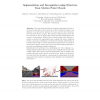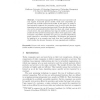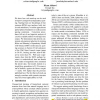302 search results - page 14 / 61 » Deriving input syntactic structure from execution |
NDSS
2008
IEEE
14 years 4 months ago
2008
IEEE
Protocol reverse engineering has often been a manual process that is considered time-consuming, tedious and error-prone. To address this limitation, a number of solutions have rec...
ECCV
2008
Springer
14 years 11 months ago
2008
Springer
We propose an algorithm for semantic segmentation based on 3D point clouds derived from ego-motion. We motivate five simple cues designed to model specific patterns of motion and 3...
BPM
2006
Springer
14 years 1 months ago
2006
Springer
Composition languages like BPEL and many enactment tools only support structured process models, while most composition approaches only consider unstructured models. In this paper,...
CORR
2007
Springer
13 years 9 months ago
2007
Springer
We introduce ‘atomic flows’: they are graphs obtained from derivations by tracing atom occurrences and forgetting the logical structure. We study simple manipulations of atomi...
ACL
2010
13 years 7 months ago
2010
We show how web mark-up can be used to improve unsupervised dependency parsing. Starting from raw bracketings of four common HTML tags (anchors, bold, italics and underlines), we ...



